Laudato Si' and Sustainable Development Goal 15: Life on Land
VerifiedAdded on 2023/06/10
|9
|2430
|496
AI Summary
This essay explores the impact of Laudato Si' on sustainable development goal 15: life on land. It discusses the teachings of Catholic social teaching and how they relate to protecting the environment. The essay also looks at TEAR Australia, a community organization working towards a sustainable future.
Contribute Materials
Your contribution can guide someone’s learning journey. Share your
documents today.
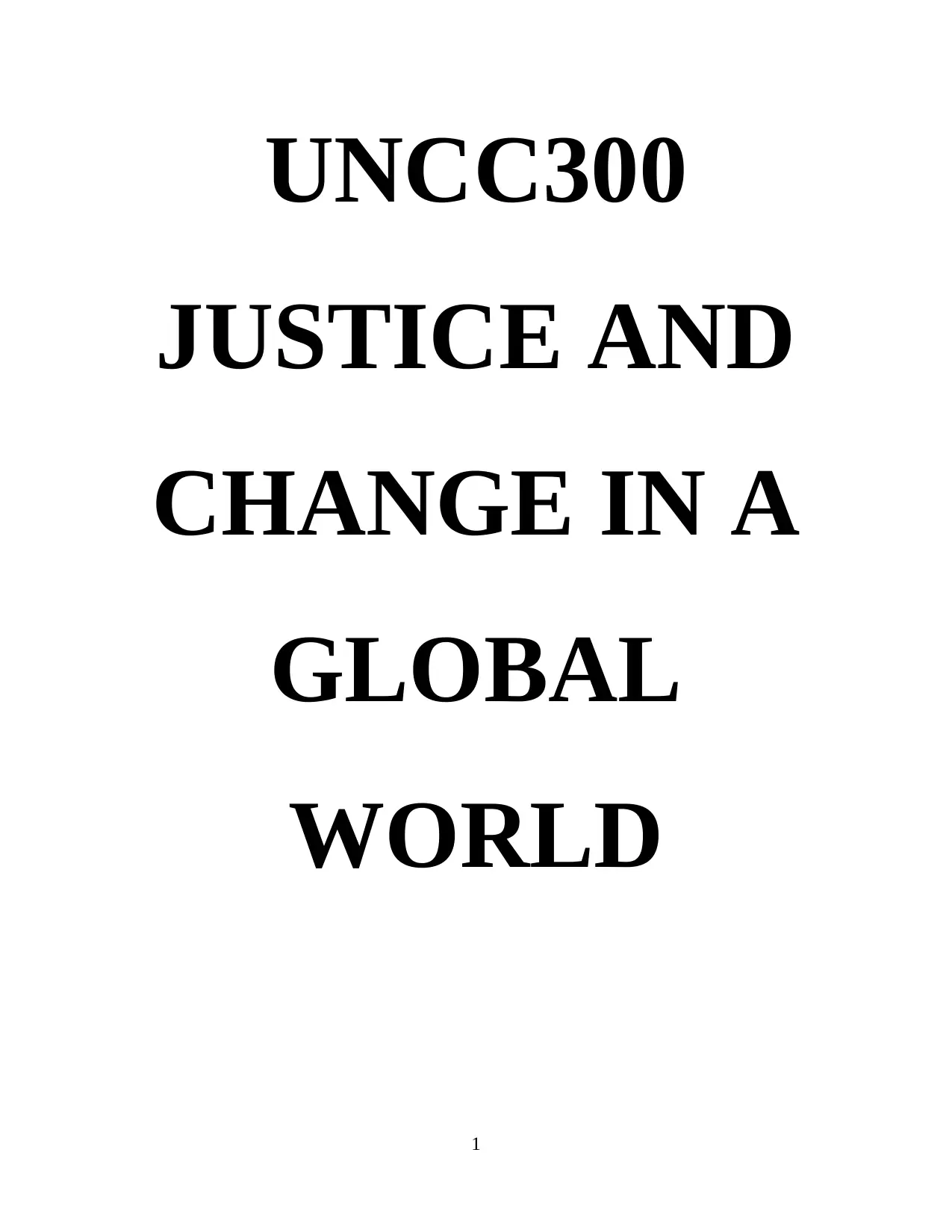
UNCC300
JUSTICE AND
CHANGE IN A
GLOBAL
WORLD
1
JUSTICE AND
CHANGE IN A
GLOBAL
WORLD
1
Secure Best Marks with AI Grader
Need help grading? Try our AI Grader for instant feedback on your assignments.
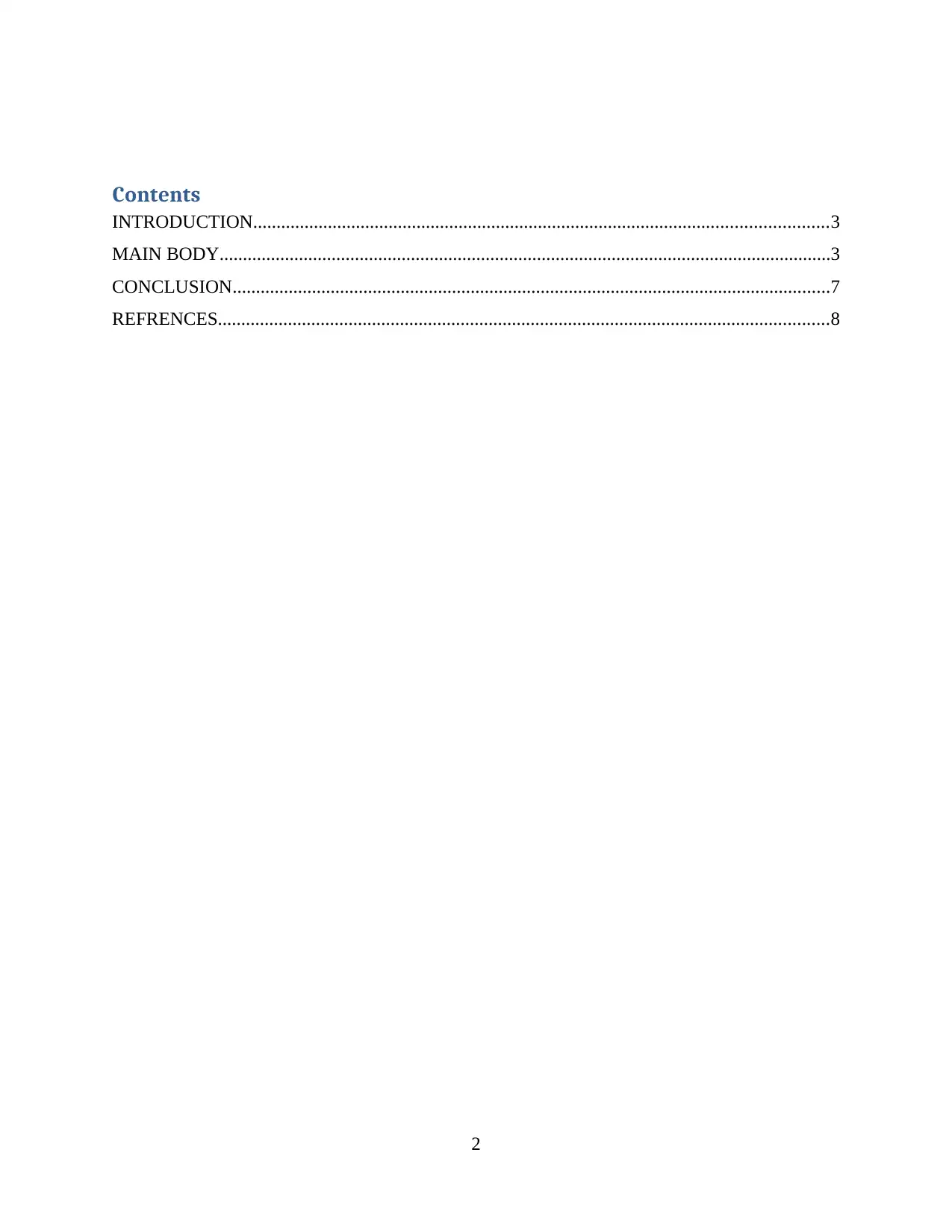
Contents
INTRODUCTION...........................................................................................................................3
MAIN BODY...................................................................................................................................3
CONCLUSION................................................................................................................................7
REFRENCES...................................................................................................................................8
2
INTRODUCTION...........................................................................................................................3
MAIN BODY...................................................................................................................................3
CONCLUSION................................................................................................................................7
REFRENCES...................................................................................................................................8
2
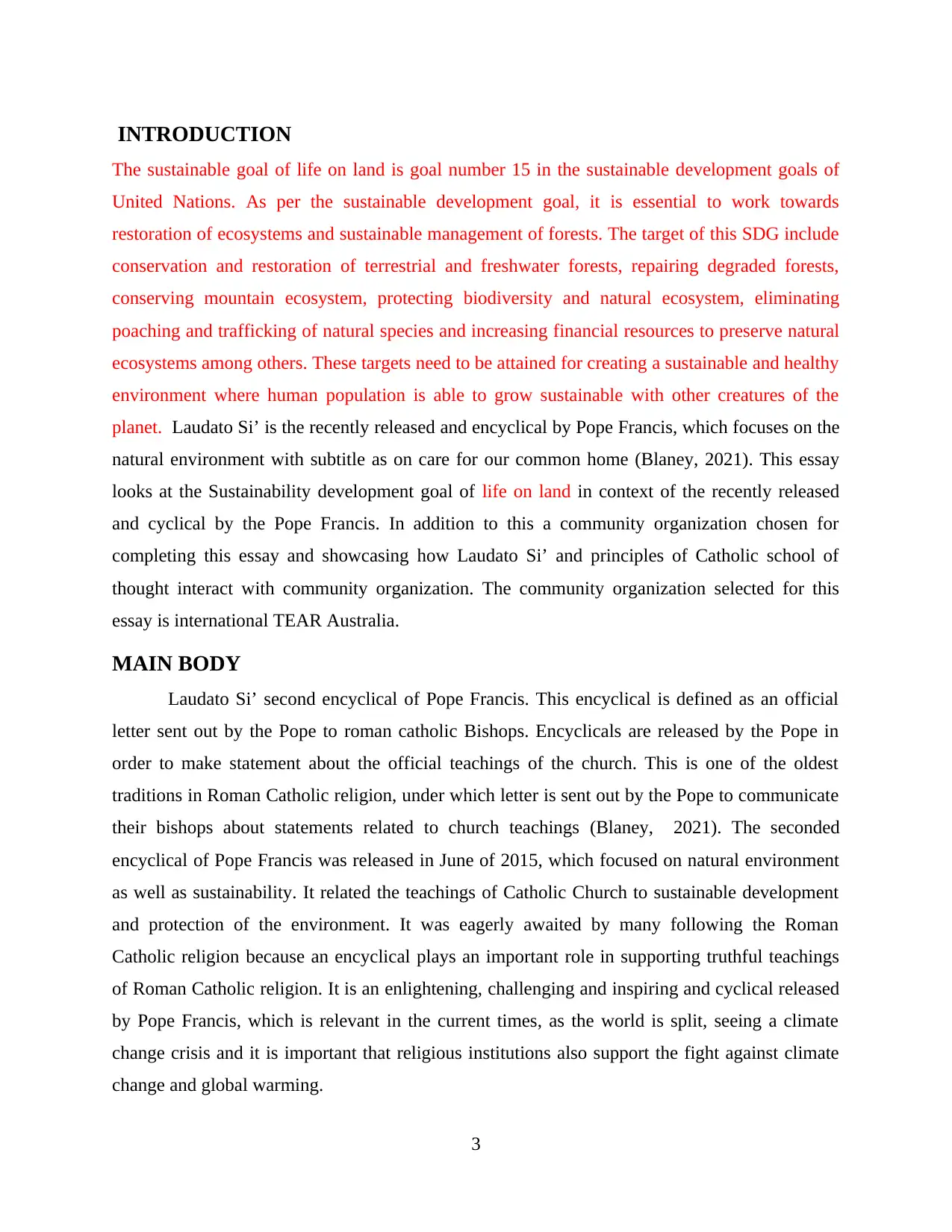
INTRODUCTION
The sustainable goal of life on land is goal number 15 in the sustainable development goals of
United Nations. As per the sustainable development goal, it is essential to work towards
restoration of ecosystems and sustainable management of forests. The target of this SDG include
conservation and restoration of terrestrial and freshwater forests, repairing degraded forests,
conserving mountain ecosystem, protecting biodiversity and natural ecosystem, eliminating
poaching and trafficking of natural species and increasing financial resources to preserve natural
ecosystems among others. These targets need to be attained for creating a sustainable and healthy
environment where human population is able to grow sustainable with other creatures of the
planet. Laudato Si’ is the recently released and encyclical by Pope Francis, which focuses on the
natural environment with subtitle as on care for our common home (Blaney, 2021). This essay
looks at the Sustainability development goal of life on land in context of the recently released
and cyclical by the Pope Francis. In addition to this a community organization chosen for
completing this essay and showcasing how Laudato Si’ and principles of Catholic school of
thought interact with community organization. The community organization selected for this
essay is international TEAR Australia.
MAIN BODY
Laudato Si’ second encyclical of Pope Francis. This encyclical is defined as an official
letter sent out by the Pope to roman catholic Bishops. Encyclicals are released by the Pope in
order to make statement about the official teachings of the church. This is one of the oldest
traditions in Roman Catholic religion, under which letter is sent out by the Pope to communicate
their bishops about statements related to church teachings (Blaney, 2021). The seconded
encyclical of Pope Francis was released in June of 2015, which focused on natural environment
as well as sustainability. It related the teachings of Catholic Church to sustainable development
and protection of the environment. It was eagerly awaited by many following the Roman
Catholic religion because an encyclical plays an important role in supporting truthful teachings
of Roman Catholic religion. It is an enlightening, challenging and inspiring and cyclical released
by Pope Francis, which is relevant in the current times, as the world is split, seeing a climate
change crisis and it is important that religious institutions also support the fight against climate
change and global warming.
3
The sustainable goal of life on land is goal number 15 in the sustainable development goals of
United Nations. As per the sustainable development goal, it is essential to work towards
restoration of ecosystems and sustainable management of forests. The target of this SDG include
conservation and restoration of terrestrial and freshwater forests, repairing degraded forests,
conserving mountain ecosystem, protecting biodiversity and natural ecosystem, eliminating
poaching and trafficking of natural species and increasing financial resources to preserve natural
ecosystems among others. These targets need to be attained for creating a sustainable and healthy
environment where human population is able to grow sustainable with other creatures of the
planet. Laudato Si’ is the recently released and encyclical by Pope Francis, which focuses on the
natural environment with subtitle as on care for our common home (Blaney, 2021). This essay
looks at the Sustainability development goal of life on land in context of the recently released
and cyclical by the Pope Francis. In addition to this a community organization chosen for
completing this essay and showcasing how Laudato Si’ and principles of Catholic school of
thought interact with community organization. The community organization selected for this
essay is international TEAR Australia.
MAIN BODY
Laudato Si’ second encyclical of Pope Francis. This encyclical is defined as an official
letter sent out by the Pope to roman catholic Bishops. Encyclicals are released by the Pope in
order to make statement about the official teachings of the church. This is one of the oldest
traditions in Roman Catholic religion, under which letter is sent out by the Pope to communicate
their bishops about statements related to church teachings (Blaney, 2021). The seconded
encyclical of Pope Francis was released in June of 2015, which focused on natural environment
as well as sustainability. It related the teachings of Catholic Church to sustainable development
and protection of the environment. It was eagerly awaited by many following the Roman
Catholic religion because an encyclical plays an important role in supporting truthful teachings
of Roman Catholic religion. It is an enlightening, challenging and inspiring and cyclical released
by Pope Francis, which is relevant in the current times, as the world is split, seeing a climate
change crisis and it is important that religious institutions also support the fight against climate
change and global warming.
3
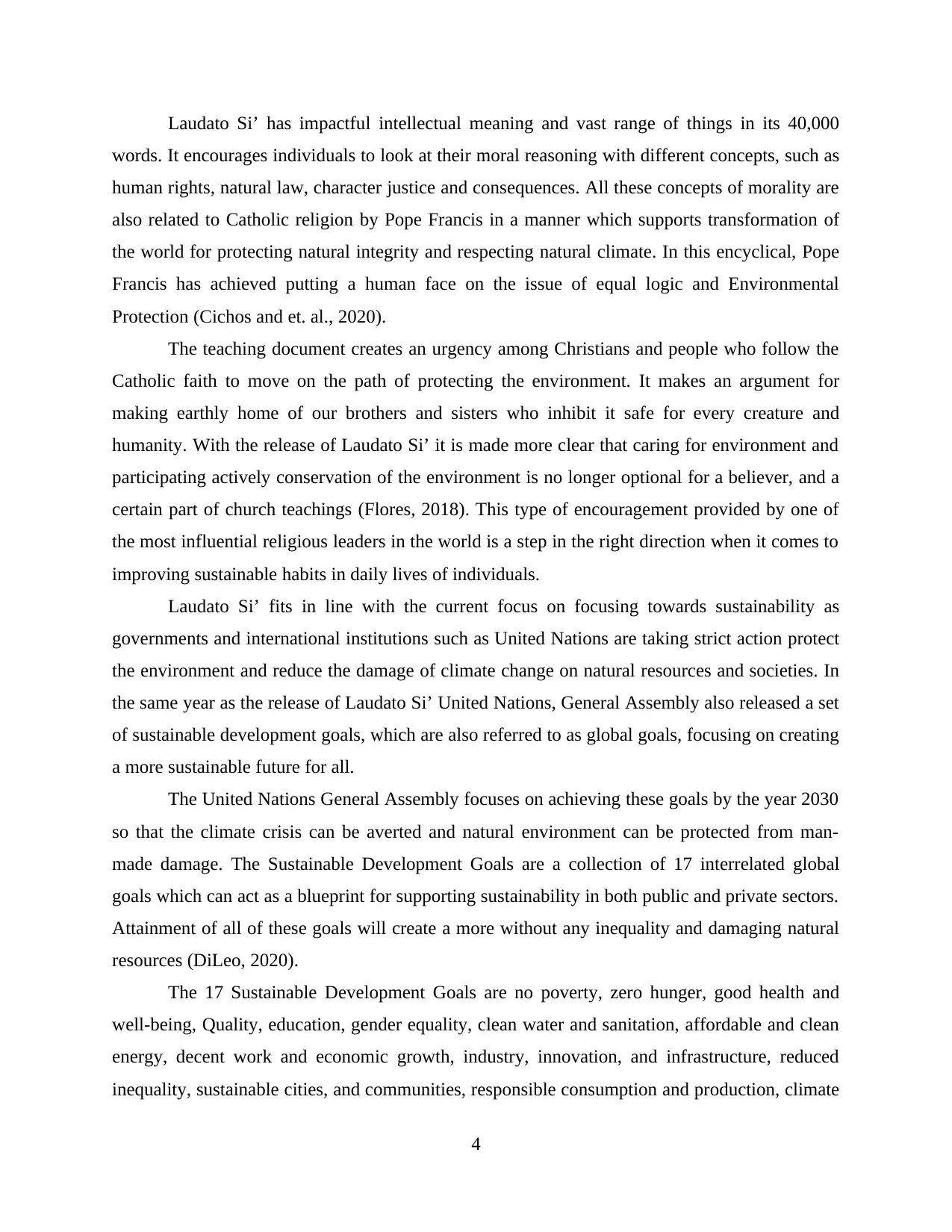
Laudato Si’ has impactful intellectual meaning and vast range of things in its 40,000
words. It encourages individuals to look at their moral reasoning with different concepts, such as
human rights, natural law, character justice and consequences. All these concepts of morality are
also related to Catholic religion by Pope Francis in a manner which supports transformation of
the world for protecting natural integrity and respecting natural climate. In this encyclical, Pope
Francis has achieved putting a human face on the issue of equal logic and Environmental
Protection (Cichos and et. al., 2020).
The teaching document creates an urgency among Christians and people who follow the
Catholic faith to move on the path of protecting the environment. It makes an argument for
making earthly home of our brothers and sisters who inhibit it safe for every creature and
humanity. With the release of Laudato Si’ it is made more clear that caring for environment and
participating actively conservation of the environment is no longer optional for a believer, and a
certain part of church teachings (Flores, 2018). This type of encouragement provided by one of
the most influential religious leaders in the world is a step in the right direction when it comes to
improving sustainable habits in daily lives of individuals.
Laudato Si’ fits in line with the current focus on focusing towards sustainability as
governments and international institutions such as United Nations are taking strict action protect
the environment and reduce the damage of climate change on natural resources and societies. In
the same year as the release of Laudato Si’ United Nations, General Assembly also released a set
of sustainable development goals, which are also referred to as global goals, focusing on creating
a more sustainable future for all.
The United Nations General Assembly focuses on achieving these goals by the year 2030
so that the climate crisis can be averted and natural environment can be protected from man-
made damage. The Sustainable Development Goals are a collection of 17 interrelated global
goals which can act as a blueprint for supporting sustainability in both public and private sectors.
Attainment of all of these goals will create a more without any inequality and damaging natural
resources (DiLeo, 2020).
The 17 Sustainable Development Goals are no poverty, zero hunger, good health and
well-being, Quality, education, gender equality, clean water and sanitation, affordable and clean
energy, decent work and economic growth, industry, innovation, and infrastructure, reduced
inequality, sustainable cities, and communities, responsible consumption and production, climate
4
words. It encourages individuals to look at their moral reasoning with different concepts, such as
human rights, natural law, character justice and consequences. All these concepts of morality are
also related to Catholic religion by Pope Francis in a manner which supports transformation of
the world for protecting natural integrity and respecting natural climate. In this encyclical, Pope
Francis has achieved putting a human face on the issue of equal logic and Environmental
Protection (Cichos and et. al., 2020).
The teaching document creates an urgency among Christians and people who follow the
Catholic faith to move on the path of protecting the environment. It makes an argument for
making earthly home of our brothers and sisters who inhibit it safe for every creature and
humanity. With the release of Laudato Si’ it is made more clear that caring for environment and
participating actively conservation of the environment is no longer optional for a believer, and a
certain part of church teachings (Flores, 2018). This type of encouragement provided by one of
the most influential religious leaders in the world is a step in the right direction when it comes to
improving sustainable habits in daily lives of individuals.
Laudato Si’ fits in line with the current focus on focusing towards sustainability as
governments and international institutions such as United Nations are taking strict action protect
the environment and reduce the damage of climate change on natural resources and societies. In
the same year as the release of Laudato Si’ United Nations, General Assembly also released a set
of sustainable development goals, which are also referred to as global goals, focusing on creating
a more sustainable future for all.
The United Nations General Assembly focuses on achieving these goals by the year 2030
so that the climate crisis can be averted and natural environment can be protected from man-
made damage. The Sustainable Development Goals are a collection of 17 interrelated global
goals which can act as a blueprint for supporting sustainability in both public and private sectors.
Attainment of all of these goals will create a more without any inequality and damaging natural
resources (DiLeo, 2020).
The 17 Sustainable Development Goals are no poverty, zero hunger, good health and
well-being, Quality, education, gender equality, clean water and sanitation, affordable and clean
energy, decent work and economic growth, industry, innovation, and infrastructure, reduced
inequality, sustainable cities, and communities, responsible consumption and production, climate
4
Secure Best Marks with AI Grader
Need help grading? Try our AI Grader for instant feedback on your assignments.
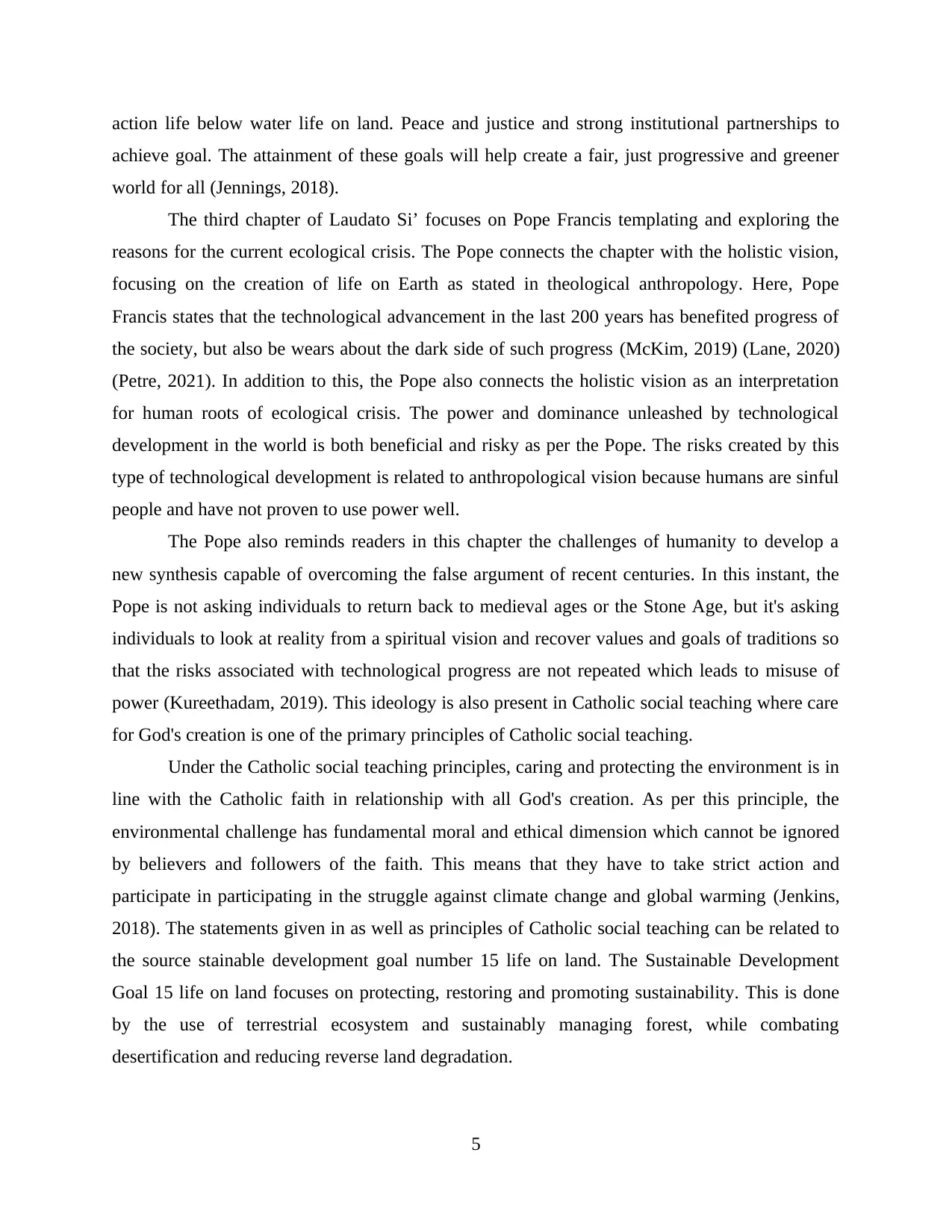
action life below water life on land. Peace and justice and strong institutional partnerships to
achieve goal. The attainment of these goals will help create a fair, just progressive and greener
world for all (Jennings, 2018).
The third chapter of Laudato Si’ focuses on Pope Francis templating and exploring the
reasons for the current ecological crisis. The Pope connects the chapter with the holistic vision,
focusing on the creation of life on Earth as stated in theological anthropology. Here, Pope
Francis states that the technological advancement in the last 200 years has benefited progress of
the society, but also be wears about the dark side of such progress (McKim, 2019) (Lane, 2020)
(Petre, 2021). In addition to this, the Pope also connects the holistic vision as an interpretation
for human roots of ecological crisis. The power and dominance unleashed by technological
development in the world is both beneficial and risky as per the Pope. The risks created by this
type of technological development is related to anthropological vision because humans are sinful
people and have not proven to use power well.
The Pope also reminds readers in this chapter the challenges of humanity to develop a
new synthesis capable of overcoming the false argument of recent centuries. In this instant, the
Pope is not asking individuals to return back to medieval ages or the Stone Age, but it's asking
individuals to look at reality from a spiritual vision and recover values and goals of traditions so
that the risks associated with technological progress are not repeated which leads to misuse of
power (Kureethadam, 2019). This ideology is also present in Catholic social teaching where care
for God's creation is one of the primary principles of Catholic social teaching.
Under the Catholic social teaching principles, caring and protecting the environment is in
line with the Catholic faith in relationship with all God's creation. As per this principle, the
environmental challenge has fundamental moral and ethical dimension which cannot be ignored
by believers and followers of the faith. This means that they have to take strict action and
participate in participating in the struggle against climate change and global warming (Jenkins,
2018). The statements given in as well as principles of Catholic social teaching can be related to
the source stainable development goal number 15 life on land. The Sustainable Development
Goal 15 life on land focuses on protecting, restoring and promoting sustainability. This is done
by the use of terrestrial ecosystem and sustainably managing forest, while combating
desertification and reducing reverse land degradation.
5
achieve goal. The attainment of these goals will help create a fair, just progressive and greener
world for all (Jennings, 2018).
The third chapter of Laudato Si’ focuses on Pope Francis templating and exploring the
reasons for the current ecological crisis. The Pope connects the chapter with the holistic vision,
focusing on the creation of life on Earth as stated in theological anthropology. Here, Pope
Francis states that the technological advancement in the last 200 years has benefited progress of
the society, but also be wears about the dark side of such progress (McKim, 2019) (Lane, 2020)
(Petre, 2021). In addition to this, the Pope also connects the holistic vision as an interpretation
for human roots of ecological crisis. The power and dominance unleashed by technological
development in the world is both beneficial and risky as per the Pope. The risks created by this
type of technological development is related to anthropological vision because humans are sinful
people and have not proven to use power well.
The Pope also reminds readers in this chapter the challenges of humanity to develop a
new synthesis capable of overcoming the false argument of recent centuries. In this instant, the
Pope is not asking individuals to return back to medieval ages or the Stone Age, but it's asking
individuals to look at reality from a spiritual vision and recover values and goals of traditions so
that the risks associated with technological progress are not repeated which leads to misuse of
power (Kureethadam, 2019). This ideology is also present in Catholic social teaching where care
for God's creation is one of the primary principles of Catholic social teaching.
Under the Catholic social teaching principles, caring and protecting the environment is in
line with the Catholic faith in relationship with all God's creation. As per this principle, the
environmental challenge has fundamental moral and ethical dimension which cannot be ignored
by believers and followers of the faith. This means that they have to take strict action and
participate in participating in the struggle against climate change and global warming (Jenkins,
2018). The statements given in as well as principles of Catholic social teaching can be related to
the source stainable development goal number 15 life on land. The Sustainable Development
Goal 15 life on land focuses on protecting, restoring and promoting sustainability. This is done
by the use of terrestrial ecosystem and sustainably managing forest, while combating
desertification and reducing reverse land degradation.
5

The statements given by Pope Francis in Laudato si can be related with the sustainable
development goal life on land because both of these documents talk about restoring and
protecting the environment as a moral and fundamental duty of every individual. In chapter four
of Laudato si, Pope Francis talks about cultural ecology and state that the analysis of
environmental problem cannot be separated from the analysis of human family, work related and
urban context (Wilczek-Karczewska, Pawlus and Waleszczyński, 2020). This means that there
needs to be a humanistic approach which integrates various fields of knowledge, including
economics, to ensure that the environment is protected and restored.
The statements given in Laudato si are similar to the focus of sustainable development
goal life on land as both of these documents are centered around restoring and protecting the
environment through human efforts and integrating different fields including science and
economic so that sustainable progress can be achieved (DiLeo, 2020). One of the sustainable
development actions which are provided under the goal life and land include protecting
biodiversity and natural habitats by promoting access to genetic resources and fair sharing of
benefits. This type of collaborative action taken by individuals to protect the environment is a
common element found in both Laudato Si’ and sustainable development goals.
The community or TEAR Australia is one of the most impactful and successful nonprofit
organization in Australia, which has able to support indigenous populations in achieving
economic, social and environmental progress in a successful manner. The Community work done
by TEAR Australia can be related to Laudato si as well as the sustainable development goal life
on land. This is because TEAR Australia focuses on populations in Australia to tackle climate
change crises in various regions in Australia and provide indigenous population chance to
improve their livelihood. TEAR Australia looks at the concept of climate change as a symptom
of the brokenness that comes with humans living outside of the way God designed. This is
similar to statements of Laudato si because it also focuses on promoting sustainability to respect
and support conservation of God’s creation (Klein and Laczniak, 2021). This type of worldview
aims to tackle climate change and restoring the environment as described in SDG 15 while also
incorporating teachings of Laudato Si’.
6
development goal life on land because both of these documents talk about restoring and
protecting the environment as a moral and fundamental duty of every individual. In chapter four
of Laudato si, Pope Francis talks about cultural ecology and state that the analysis of
environmental problem cannot be separated from the analysis of human family, work related and
urban context (Wilczek-Karczewska, Pawlus and Waleszczyński, 2020). This means that there
needs to be a humanistic approach which integrates various fields of knowledge, including
economics, to ensure that the environment is protected and restored.
The statements given in Laudato si are similar to the focus of sustainable development
goal life on land as both of these documents are centered around restoring and protecting the
environment through human efforts and integrating different fields including science and
economic so that sustainable progress can be achieved (DiLeo, 2020). One of the sustainable
development actions which are provided under the goal life and land include protecting
biodiversity and natural habitats by promoting access to genetic resources and fair sharing of
benefits. This type of collaborative action taken by individuals to protect the environment is a
common element found in both Laudato Si’ and sustainable development goals.
The community or TEAR Australia is one of the most impactful and successful nonprofit
organization in Australia, which has able to support indigenous populations in achieving
economic, social and environmental progress in a successful manner. The Community work done
by TEAR Australia can be related to Laudato si as well as the sustainable development goal life
on land. This is because TEAR Australia focuses on populations in Australia to tackle climate
change crises in various regions in Australia and provide indigenous population chance to
improve their livelihood. TEAR Australia looks at the concept of climate change as a symptom
of the brokenness that comes with humans living outside of the way God designed. This is
similar to statements of Laudato si because it also focuses on promoting sustainability to respect
and support conservation of God’s creation (Klein and Laczniak, 2021). This type of worldview
aims to tackle climate change and restoring the environment as described in SDG 15 while also
incorporating teachings of Laudato Si’.
6
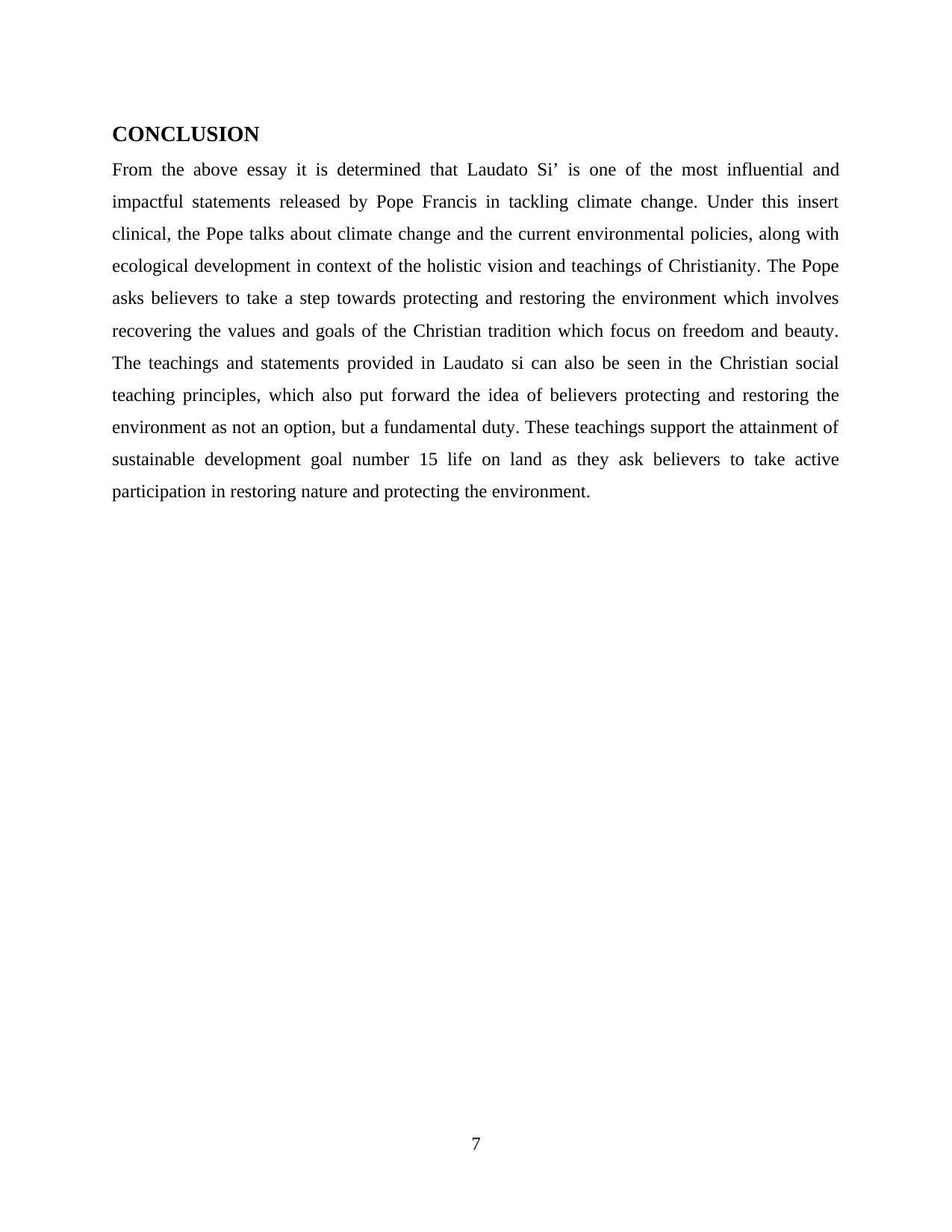
CONCLUSION
From the above essay it is determined that Laudato Si’ is one of the most influential and
impactful statements released by Pope Francis in tackling climate change. Under this insert
clinical, the Pope talks about climate change and the current environmental policies, along with
ecological development in context of the holistic vision and teachings of Christianity. The Pope
asks believers to take a step towards protecting and restoring the environment which involves
recovering the values and goals of the Christian tradition which focus on freedom and beauty.
The teachings and statements provided in Laudato si can also be seen in the Christian social
teaching principles, which also put forward the idea of believers protecting and restoring the
environment as not an option, but a fundamental duty. These teachings support the attainment of
sustainable development goal number 15 life on land as they ask believers to take active
participation in restoring nature and protecting the environment.
7
From the above essay it is determined that Laudato Si’ is one of the most influential and
impactful statements released by Pope Francis in tackling climate change. Under this insert
clinical, the Pope talks about climate change and the current environmental policies, along with
ecological development in context of the holistic vision and teachings of Christianity. The Pope
asks believers to take a step towards protecting and restoring the environment which involves
recovering the values and goals of the Christian tradition which focus on freedom and beauty.
The teachings and statements provided in Laudato si can also be seen in the Christian social
teaching principles, which also put forward the idea of believers protecting and restoring the
environment as not an option, but a fundamental duty. These teachings support the attainment of
sustainable development goal number 15 life on land as they ask believers to take active
participation in restoring nature and protecting the environment.
7
Paraphrase This Document
Need a fresh take? Get an instant paraphrase of this document with our AI Paraphraser
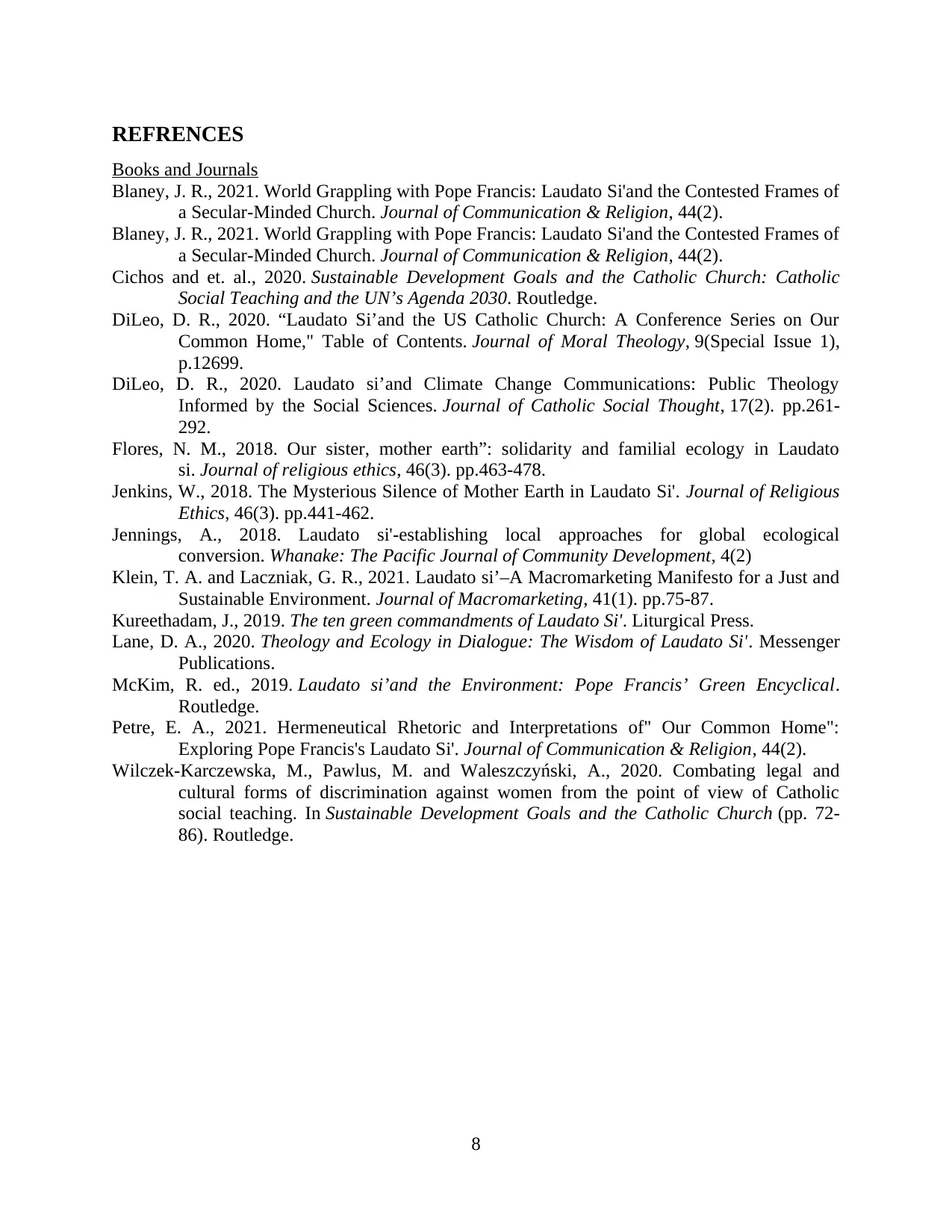
REFRENCES
Books and Journals
Blaney, J. R., 2021. World Grappling with Pope Francis: Laudato Si'and the Contested Frames of
a Secular-Minded Church. Journal of Communication & Religion, 44(2).
Blaney, J. R., 2021. World Grappling with Pope Francis: Laudato Si'and the Contested Frames of
a Secular-Minded Church. Journal of Communication & Religion, 44(2).
Cichos and et. al., 2020. Sustainable Development Goals and the Catholic Church: Catholic
Social Teaching and the UN’s Agenda 2030. Routledge.
DiLeo, D. R., 2020. “Laudato Si’and the US Catholic Church: A Conference Series on Our
Common Home," Table of Contents. Journal of Moral Theology, 9(Special Issue 1),
p.12699.
DiLeo, D. R., 2020. Laudato si’and Climate Change Communications: Public Theology
Informed by the Social Sciences. Journal of Catholic Social Thought, 17(2). pp.261-
292.
Flores, N. M., 2018. Our sister, mother earth”: solidarity and familial ecology in Laudato
si. Journal of religious ethics, 46(3). pp.463-478.
Jenkins, W., 2018. The Mysterious Silence of Mother Earth in Laudato Si'. Journal of Religious
Ethics, 46(3). pp.441-462.
Jennings, A., 2018. Laudato si'-establishing local approaches for global ecological
conversion. Whanake: The Pacific Journal of Community Development, 4(2)
Klein, T. A. and Laczniak, G. R., 2021. Laudato si’–A Macromarketing Manifesto for a Just and
Sustainable Environment. Journal of Macromarketing, 41(1). pp.75-87.
Kureethadam, J., 2019. The ten green commandments of Laudato Si'. Liturgical Press.
Lane, D. A., 2020. Theology and Ecology in Dialogue: The Wisdom of Laudato Si'. Messenger
Publications.
McKim, R. ed., 2019. Laudato si’and the Environment: Pope Francis’ Green Encyclical.
Routledge.
Petre, E. A., 2021. Hermeneutical Rhetoric and Interpretations of" Our Common Home":
Exploring Pope Francis's Laudato Si'. Journal of Communication & Religion, 44(2).
Wilczek-Karczewska, M., Pawlus, M. and Waleszczyński, A., 2020. Combating legal and
cultural forms of discrimination against women from the point of view of Catholic
social teaching. In Sustainable Development Goals and the Catholic Church (pp. 72-
86). Routledge.
8
Books and Journals
Blaney, J. R., 2021. World Grappling with Pope Francis: Laudato Si'and the Contested Frames of
a Secular-Minded Church. Journal of Communication & Religion, 44(2).
Blaney, J. R., 2021. World Grappling with Pope Francis: Laudato Si'and the Contested Frames of
a Secular-Minded Church. Journal of Communication & Religion, 44(2).
Cichos and et. al., 2020. Sustainable Development Goals and the Catholic Church: Catholic
Social Teaching and the UN’s Agenda 2030. Routledge.
DiLeo, D. R., 2020. “Laudato Si’and the US Catholic Church: A Conference Series on Our
Common Home," Table of Contents. Journal of Moral Theology, 9(Special Issue 1),
p.12699.
DiLeo, D. R., 2020. Laudato si’and Climate Change Communications: Public Theology
Informed by the Social Sciences. Journal of Catholic Social Thought, 17(2). pp.261-
292.
Flores, N. M., 2018. Our sister, mother earth”: solidarity and familial ecology in Laudato
si. Journal of religious ethics, 46(3). pp.463-478.
Jenkins, W., 2018. The Mysterious Silence of Mother Earth in Laudato Si'. Journal of Religious
Ethics, 46(3). pp.441-462.
Jennings, A., 2018. Laudato si'-establishing local approaches for global ecological
conversion. Whanake: The Pacific Journal of Community Development, 4(2)
Klein, T. A. and Laczniak, G. R., 2021. Laudato si’–A Macromarketing Manifesto for a Just and
Sustainable Environment. Journal of Macromarketing, 41(1). pp.75-87.
Kureethadam, J., 2019. The ten green commandments of Laudato Si'. Liturgical Press.
Lane, D. A., 2020. Theology and Ecology in Dialogue: The Wisdom of Laudato Si'. Messenger
Publications.
McKim, R. ed., 2019. Laudato si’and the Environment: Pope Francis’ Green Encyclical.
Routledge.
Petre, E. A., 2021. Hermeneutical Rhetoric and Interpretations of" Our Common Home":
Exploring Pope Francis's Laudato Si'. Journal of Communication & Religion, 44(2).
Wilczek-Karczewska, M., Pawlus, M. and Waleszczyński, A., 2020. Combating legal and
cultural forms of discrimination against women from the point of view of Catholic
social teaching. In Sustainable Development Goals and the Catholic Church (pp. 72-
86). Routledge.
8

1
1 out of 9
Your All-in-One AI-Powered Toolkit for Academic Success.
+13062052269
info@desklib.com
Available 24*7 on WhatsApp / Email
![[object Object]](/_next/static/media/star-bottom.7253800d.svg)
Unlock your academic potential
© 2024 | Zucol Services PVT LTD | All rights reserved.

